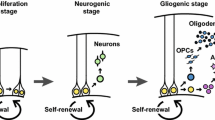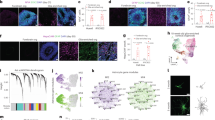Abstract
To examine the role of gray and white matter niches for oligodendrocyte differentiation, we used homo- and heterotopic transplantations into the adult mouse cerebral cortex. White matter–derived cells differentiated into mature oligodendrocytes in both niches with equal efficiency, whereas gray matter–derived cells did not. Thus, white matter promotes oligodendrocyte differentiation, and cells from this niche differentiate more easily, even in the less supportive gray matter environment.


Similar content being viewed by others
References
Dawson, M.R., Polito, A., Levine, J.M. & Reynolds, R. Mol. Cell. Neurosci. 24, 476–488 (2003).
Pringle, N.P., Mudhar, H.S., Collarini, E.J. & Richardson, W.D. Development 115, 535–551 (1992).
Dimou, L., Simon, C., Kirchhoff, F., Takebayashi, H. & Götz, M. J. Neurosci. 28, 10434–10442 (2008).
Rivers, L.E. et al. Nat. Neurosci. 11, 1392–1401 (2008).
Zhu, X. et al. Development 138, 745–753 (2011).
Kang, S.H., Fukaya, M., Yang, J.K., Rothstein, J.D. & Bergles, D.E. Neuron 68, 668–681 (2010).
Okabe, M., Ikawa, M., Kominami, K., Nakanishi, T. & Nishimune, Y. FEBS Lett. 407, 313–319 (1997).
Hirrlinger, P.G. et al. Mol. Cell. Neurosci. 30, 291–303 (2005).
Fancy, S.P., Chan, J.R., Baranzini, S.E., Franklin, R.J. & Rowitch, D.H. Annu. Rev. Neurosci. 34, 21–43 (2011).
Emery, B. Science 330, 779–782 (2010).
Rosenberg, S.S., Kelland, E.E., Tokar, E., De la Torre, A.R. & Chan, J.R. Proc. Natl. Acad. Sci. USA 105, 14662–14667 (2008).
Gudi, V. et al. Brain Res. 1283, 127–138 (2009).
Albert, M., Antel, J., Bruck, W. & Stadelmann, C. Brain Pathol. 17, 129–138 (2007).
Karram, K. et al. Genesis 46, 743–757 (2008).
Fischer, J. et al. Nat. Protoc. 6, 1981–1989 (2011).
Simon, C., Götz, M. & Dimou, L. Glia 59, 869–881 (2011).
Peters, P.J. & Pierson, J. Methods Cell Biol. 88, 131–149 (2008).
Werner, H.B. et al. J. Neurosci. 27, 7717–7730 (2007).
Acknowledgements
We thank J. Trotter (Johannes Gutenberg-University) for the NG2-EYFP and F. Kirchhoff (University of Saarland) for the PLP-DsRed mouse lines, K. Karram for advice regarding cell isolation procedures, J. Ninkovic for help with the statistics, and E. Violette and S. Sirko for carefully reading the manuscript. We are also grateful to B. Sadowski for technical help with the electron microscope, as well as the technical assistants in the Physiological Genomics. W.M. is funded by the European Research Council Advanced Investigator Grant AXOGLIA to K.-A. Nave and is supported by the Cluster of Excellence and DFG research Center Nanoscale Microscopy and Molecular Physiology of the Brain. F.V. was, in part, supported by a doctorate fellowship from the University of Milan and an International Brain Research Organization InEurope grant. This work was mainly supported by the SFB 596 and the SFB 870 of the Deutsche Forschungsgemeinschaft, the Helmholtz Association of Mental Aging and the Friedrich Bauer Stiftung.
Author information
Authors and Affiliations
Contributions
F.V. performed and designed the experiments, analyzed the data, and wrote the manuscript. W.M. performed and analyzed the immunoelectron microscopy. M.G. helped to design some experiments and wrote the manuscript. L.D. designed and supervised experiments, originally developed the transplantation technique, and wrote the manuscript. F.V., M.G. and L.D. discussed the results and implications and commented on the manuscript at all stages.
Corresponding author
Ethics declarations
Competing interests
The authors declare no competing financial interests.
Supplementary information
Supplementary Text and Figures
Supplementary Figures 1–4 (PDF 1224 kb)
Source data
Rights and permissions
About this article
Cite this article
Viganò, F., Möbius, W., Götz, M. et al. Transplantation reveals regional differences in oligodendrocyte differentiation in the adult brain. Nat Neurosci 16, 1370–1372 (2013). https://doi.org/10.1038/nn.3503
Received:
Accepted:
Published:
Issue Date:
DOI: https://doi.org/10.1038/nn.3503
- Springer Nature America, Inc.
This article is cited by
-
Clemastine and metformin extend the window of NMDA receptor surface expression in ageing oligodendrocyte precursor cells
Scientific Reports (2024)
-
Oligodendrocyte death initiates synchronous remyelination to restore cortical myelin patterns in mice
Nature Neuroscience (2023)
-
Myelination-independent functions of oligodendrocyte precursor cells in health and disease
Nature Neuroscience (2023)
-
Astrocyte-mediated Oligodendrocyte Precursor Cells Detachment from Vessels
Cell Biochemistry and Biophysics (2023)
-
Recombinant Erythropoietin Induces Oligodendrocyte Progenitor Cell Proliferation After Traumatic Brain Injury and Delayed Hypoxemia
Neurotherapeutics (2023)





